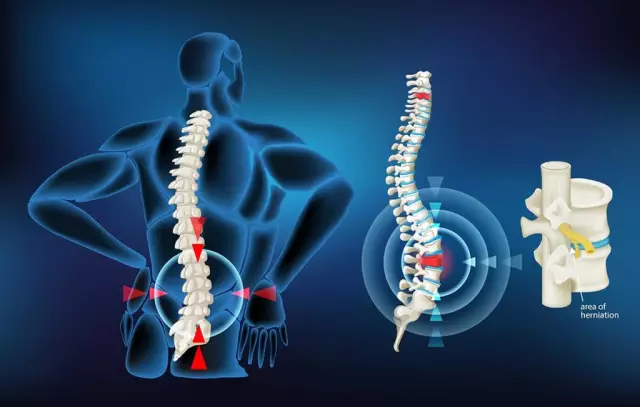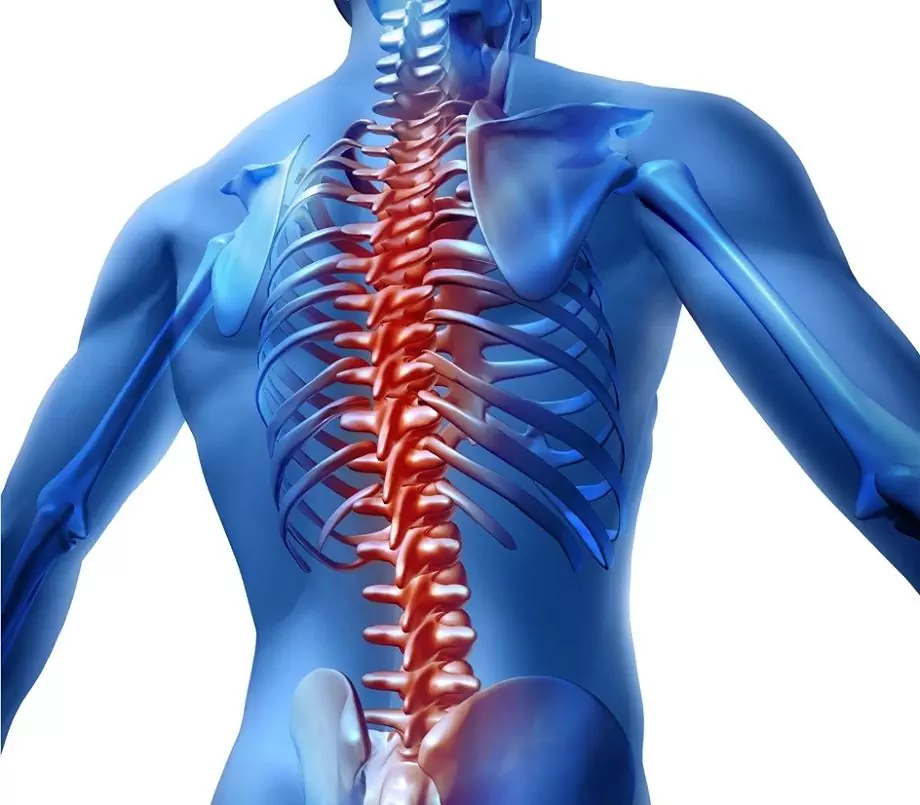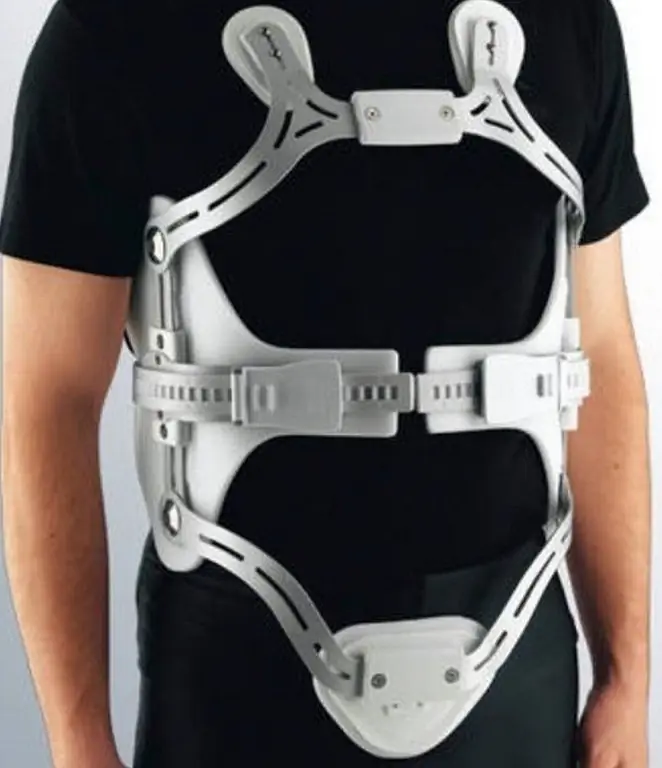- Author Rachel Wainwright [email protected].
- Public 2023-12-15 07:39.
- Last modified 2025-11-02 20:14.
What hurts with a hernia of the spine

An intervertebral hernia is a protrusion of the internal nucleus pulposus beyond the anatomical localization. The vertebral nucleus consists of cartilaginous tissue rich in hyaluronic acid, which gives it a jelly-like, but dense consistency. Around the circumference of the vertebral body, the nucleus pulposus is protected by a fibrous ring, which also consists of cartilage tissue, but of dense collagen fibers. The structure of the intervertebral discs ensures smooth movement of the spine.
A hernia, in fact, is a protrusion of an internal organ or part of it beyond the anatomical localization. In the formation of this pathology, two factors play a decisive role:
- Increased internal pressure;
- Destruction of the barrier that fences off the internal organs.
With a long-term current inflammatory process, dystrophic changes in the annulus fibrosus occur. The distance between the fibers increases, cracks appear. However, pain in spinal hernias does not appear from the fact that the cartilaginous tissue is destroyed, but from the compression of the nerve endings and vascular bundles of the spine by the prolapsed tissue of the nucleus pulposus, the soft and elastic structure of which, outside the anatomical localization, undergoes ossification - ossification. The formed bony ridges squeeze nerve endings and small vessels.
Mechanisms of the appearance of pain in spinal hernias
When part of the nucleus of the vertebral disc leaves in one direction or another, the nerve bundles emanating from the trunk of the spinal cord in the area of each vertebra are compressed. The central nervous system of the spinal cord has a segmental structure. There are the following divisions of innervation of certain areas:
- Cervical;
- Chest;
- Lumbar;
- Sacral.
Nerve fibers emanating from the spinal column on both sides of the body provide motor activity and sensitivity of the right or left half. Accordingly, there are pains with hernias of the spine in those sections where the anatomical destruction of the intervertebral discs is localized.
What are the pains with a hernia of the spine when localized in different parts of the spinal cord
Pain in herniated intervertebral discs differ not only in intensity, but also in localization.
Hernias of the cervical spine provoke pain in the upper limbs and shoulder girdle, and are also characterized by severe, paroxysmal headaches. With the progression of the disease, pain in hernia of the cervical spine provokes muscle spasm. As a result, the patient cannot turn his head. Often, hernias of the cervical spine are accompanied by dizziness due to changes in blood pressure. Patients are diagnosed with vegetative-vascular dystonia, which is treated symptomatically. However, the cause is not eliminated. Meanwhile, the herniated disc progresses. A headache with this pathology has some peculiarities. It manifests itself not on the side of the lesion of the spinal column, but has a diffuse character. Starting in the occipital region,headaches with a hernia of the spine spread throughout the skull. The person cannot get into a comfortable sleeping position. With a high pillow, the head hurts, with a low pillow, the intensity of pain does not decrease. Insomnia develops. Sleeping pills have no effect, since inhibition of the central nervous system does not eliminate the mechanical cause of the compression of the nerve roots.
The defeat of the intervertebral discs of the thoracic region appears by intercostal neuralgia, which at first mimics cardiac pathology. Pains appear behind the sternum due to damage to the nerve plexus. Further development of the disease leads to a violation of the innervation of the heart and to a failure of the myocardial automatism. Arrhythmias without sites of anatomical lesion of the myocardium often accompany hernias of the thoracic spine.
The lumbar region is physiologically combined with the sacral region. In the region of the lumbosacral joint, an anatomical formation called the "cauda equina of the spinal cord" is localized. With his defeat, pain in spinal hernias is accompanied by disorders of the functions of the pelvic organs. Disturbed urination in the form of retention or urinary incontinence, constipation interspersed with diarrhea.
The initial stage of the disease is characterized by acute pain of the lumbago type - lumbago. At the time of an acute attack, a person freezes, cannot bend or straighten. These are the pains with a hernia of the spine that are alarming in the first place, because with long-term osteochondrosis, the patient gradually adapts to pain, gets used to the fact that his movements are limited by pain. If a herniated disc develops, all previous efforts to overcome it cease to be effective.
Why and how a leg hurts with a hernia of the spine
The innervation of the lower extremities depends on specific segments of the spine, more precisely, on the outgoing nerve bundles in the region of the fourth and fifth lumbar vertebrae. When the intervertebral disc is damaged between L 4 and L 5 (the Latin letter "L" - "lumbar", meaning "lumbar"), a radicular syndrome develops with damage to the femoral nerve. In this case, the leg hurts with a hernia of the spine on the outside: from the thigh to the little finger. When a hernia forms at the L 5 -S 1 level("Lumbar-sacralis": in the lumbosacral region), pain in the lower limb spreads along the sciatic nerve. The painful area starts from the buttock and continues along the back of the thigh to the big toe. With further progression of the disease, impaired sensitivity and muscle atrophy develop.
How to relieve pain with a hernia of the spine
Acute pain accompanied by paralysis of the legs or arms cannot be relieved by any medication. Disorders of the pelvic organs in the form of "horse tail syndrome" are subject only to surgical treatment. Anesthesia in this case gives the supply of general anesthesia, and the subsequent removal of the intervertebral disc and its sequestration guarantees the absence of pain after the operation.

But it is possible to relieve pain with a hernia of the spine in a conservative way. To date, there are two methods for relieving pain in intervertebral hernias. Proponents of the classical approach to treatment recommend bed rest in the acute period. To relieve swelling of the nervous tissue, non-hormonal anti-inflammatory drugs are used. In a state of improvement, massage, physiotherapy, and therapeutic exercises are prescribed. In case of acute, shooting pain, blockages are performed with painkillers and vitamins.
Proponents of active tactics suggest relieving pain in spinal hernias with the help of exercises that stretch the spinal column. The traction relieves the load on the vertebrae and the pressure inside the nucleus pulposus. As a result, pain decreases, or disappears altogether.
The active technique requires the supervision of a physician, since independent attempts to stretch the spine can lead to the prolapse of part of the disc and the formation of sequestration.
YouTube video related to the article:
Found a mistake in the text? Select it and press Ctrl + Enter.






